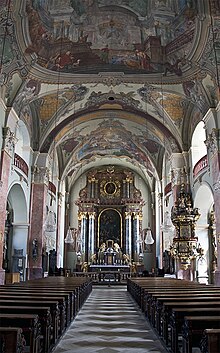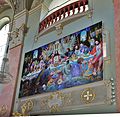Parish Church Klagenfurt-St. Egid

The Roman Catholic parish church of Klagenfurt-St. Egid is in the municipality of Klagenfurt am Wörthersee in Carinthia . The parish church of St. Agidius belongs to the dean's office of Klagenfurt-Stadt in the diocese of Gurk-Klagenfurt . The former main parish church is a listed building .
history
At the site of today's St. Egid Church there was an older church building, which was first mentioned in 1255 as the vicariate of Maria Saal and was given parish rights in 1303. 1347 was the first documented mention of a church “sand Gilgen” (St. Egid). In 1519 three priests were named at the church of St. Egid in the schematic and in 1540 the church was restored.
The structure of the original church can be seen from existing city maps from 1605 and 1649. The church had a Gothic high choir , seven altars, a projecting transept and two towers with pointed helmets, which were connected by a covered wooden corridor.
From 1563 until the re-Catholicization in 1600, Protestant services were celebrated in the church. In 1571 the keeping of baptismal records began . From 1593 Johannes Herold was cantor . In 1603 the parish became independent.
Fires destroyed the rectory in 1535 and 1636. The Romanesque Karner fell victim to the fire in 1636. Earthquakes affected the church in 1571, 1680 and 1688. The damage made it necessary to demolish the Romanesque church in 1690.
The new church was inaugurated by Bishop Kaspar von Lavant on September 8, 1697. The foundation stone for the new tower was laid by the Burgrave of Klagenfurt, JF Graf Orsini-Rosenberg, on July 30, 1692. The new bell rang for the first time in 1706 and the tower was completed in 1709. In 1723 there was renewed fire damage to the church and tower. Then the tower was equipped with a baroque onion helmet. With a height of 91.7 meters, it is the second highest church tower in Carinthia after the city parish tower in Villach and is considered one of the two landmarks of Klagenfurt. The tower gallery's 50-meter-high viewing platform can be climbed as part of guided tours .
The new church was designed as a four- bay gallery church with a two-bay square choir . Several barrel vault with lunettes rest on stucco lustro - pilasters with ornate capitals . The triumphal arch is indicated by a belt arch on wall pillars. Four side chapels with cross vaults and baroque windows complete the building. The galleries have lunette windows that also date from the Baroque period.
Four artistically valuable side altars complete the interior:
- Nepomuk Altarpiece (1822): The altar is made of artificial marble and contains the motif John the Baptist (1728) by Josef Ferdinand Fromiller and figures of the Holy Family on the side. The altar was donated by Egger-Lodron.
- Cross Altar (1702). The middle picture Crucifixion of Christ was painted by Adam Imhof in 1607.
- Barbara- Altar (1702). Main picture: Saint Barbara with tower and chalice.
- Josefs- Altar (1699) donated by the Orsini-Rosenberg family. Main picture: Saint Joseph. Top image: The Marriage of Mary (both assigned to the Klagenfurt painter Adam Claus).
In 1729 the new high altar was erected, which was replaced for the first time in 1742 and in 1780 by the high altar that has existed since then.
Around 1740 Benedikt Bläß created a baroque pulpit that can be regarded as one of the most beautiful in Carinthia; their main theme is the aspect of repentance. 1749 was the introduction of the main holy prayer under Lorenz Klein. In 1760/61 the ceiling frescoes by Fromiller and Mölckh were installed .
During this time the parish had the branch churches Heiliger Geist (consecrated 1639) and Kreuzbergl (consecrated 1742). In 1772 the cemetery in front of the church, which was the burial place for the whole city, was closed. In 1780 there were 9,689 people in St. Egid, 8,344 of whom were 'communicants'. In 1784 the three city parishes were regulated under Emperor Joseph II.
The storm damage caused by two hurricanes from 1817 to 1827 made a ceiling renovation necessary. In this context, a new bell was inaugurated in 1827. In 1832 the legal connection between the parish and the Gurk cathedral chapter was dissolved. The interior of the church was restored from 1859 to 1861. In 1877 the church tower was renovated again.
Architect Franz Schachner redesigned the facade in 1893 and a Maria Lourdes statue has stood in the northeast of the church since 1895. In 1906 Novak built a new organ for the church. In 1909 the row of houses on the old ring wall (including the organist's house) to Heuplatz was razed.
During the First World War the bells of the church were removed and taken away. In 1924 a new bell was inaugurated, which consisted of the poor soul, Florian, Marien, hero and home bells. In 1942, with the exception of the home bell, the bells were again transported away for war purposes. During National Socialism there were severe restrictions on the church. the church and parsonage were largely spared during the heavy bombing in Klagenfurt.
In 1932 the church music association at St. Egid was founded. Also in 1932 the Christ the King's Church and the new priest's house on the Lend Canal were consecrated. In 1972 the parish of St. Hemma was created by separating an area in the northwest of St. Egid.
The new rectory was built from 1964 to 1965. From 1969 to 1974 the church was renovated inside and from 1982 to 1984 the outside including the tower. From 1989 Ernst Fuchs designed the southern sacristy as a chapel.
In 1990 the church got a new bell, in 1992 an organ from the Czech organ building company Rieger-Kloss and in 2006 an overall restoration was carried out. The rectory was expanded from 2006 to 2007 and an underground car park was built.
Last Supper picture in the choir by Ernst Fuchs
organ
The organ was built in 1992 by the Rieger-Kloss organ building company. The instrument has 57 stops on three manuals and a pedal . In addition, the instrument has four effect registers ( Zymbelstern , Cuculus , bird voices and glockenspiel) and a connection to the tower bells. The game actions are mechanical, the stop actions are mechanical and electrical.
|
|
|
|
|||||||||||||||||||||||||||||||||||||||||||||||||||||||||||||||||||||||||||||||||||||||||||||||||||||||||||||||||||||||||||||||||||||||||||||||||||||||||||||||||||||||||||||||||||||||||||||||
- Coupling : II / I, III / I, III / II, I / P, II / P, III / P
- Playing aids : 196-fold setting system , crescendo roller ,
Personalities
The writer Julien Green was buried in 1998 at his own request in the main parish church of St. Egid in a chapel designed for him. The grave is adorned with a text from his diary from November 1954.
The Austrian painter Ernst Fuchs designed an apocalyptic sequence of scenes for the south chapel ("Fuchs-Kapelle") from 1991 to 2010.
Web links
Individual evidence
- ↑ Description of the organ from Rieger-Kloss in St. Egid ( Memento of the original from September 24, 2015 in the Internet Archive ) Info: The archive link was inserted automatically and has not yet been checked. Please check the original and archive link according to the instructions and then remove this notice. orgelland.at
Coordinates: 46 ° 37 ′ 33.8 " N , 14 ° 18 ′ 26.8" E









